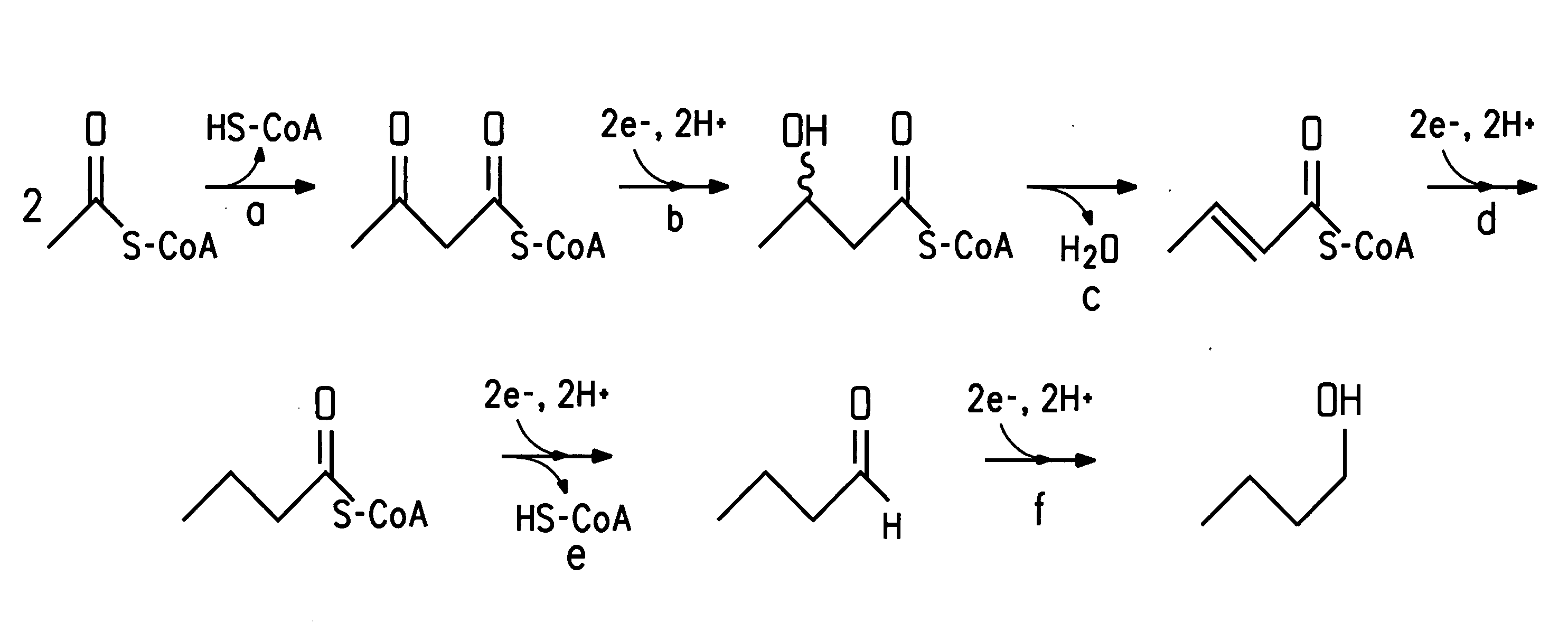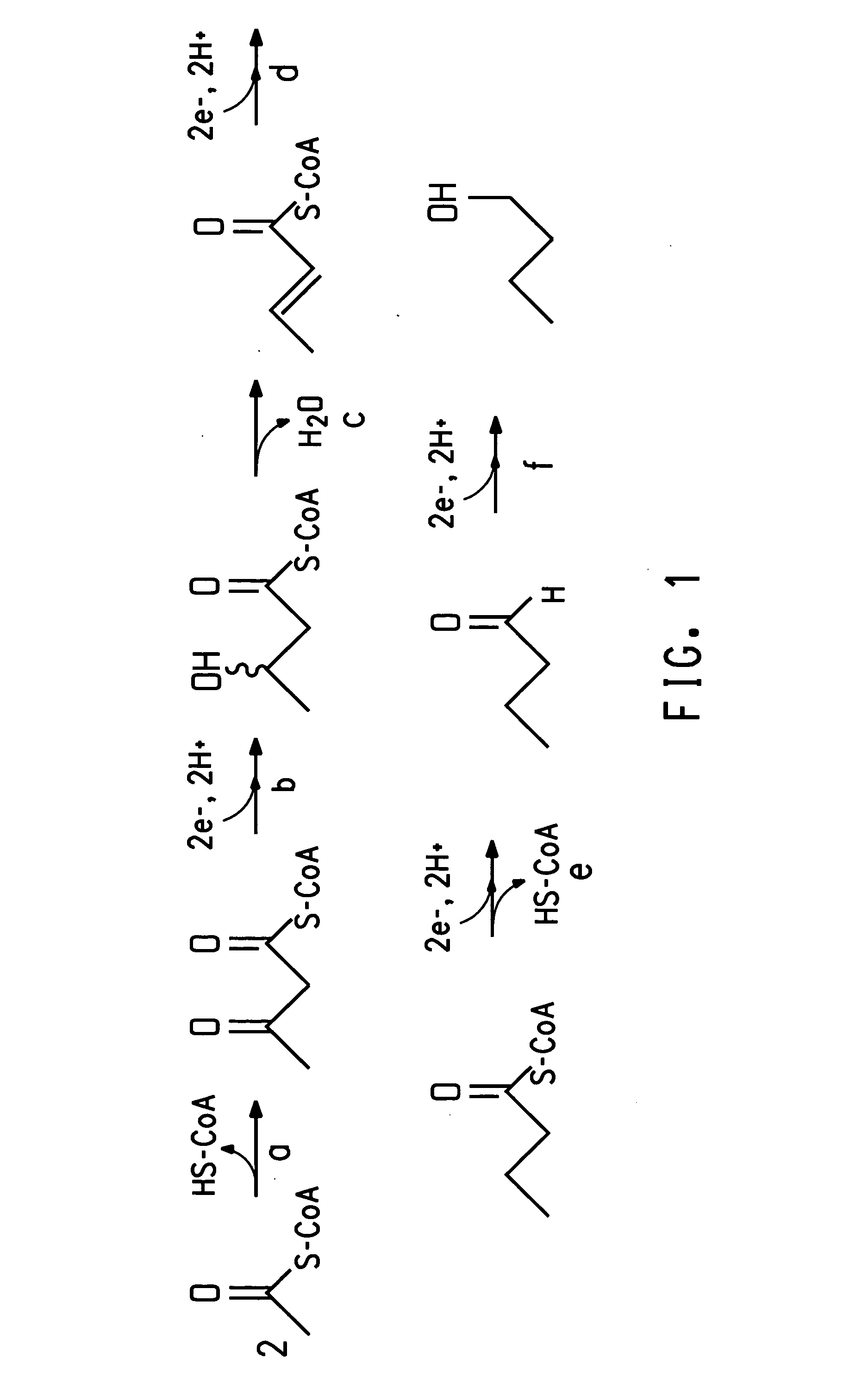Fermentive production of four carbon alcohols
a fermentation process and four carbon technology, applied in the field of industrial microbiology and the production of alcohols, can solve the problems of high cost, unenvironmental protection, and difficulty in controlling actual fermentation, and achieve the goal of maximizing the 1-butanol production of the abe process by eliminating all the other solvent by-products, and not being totally successful.
- Summary
- Abstract
- Description
- Claims
- Application Information
AI Technical Summary
Benefits of technology
Problems solved by technology
Method used
Image
Examples
example 1
Cloning and Expression of Acetyl-CoA Acetyltransferase
[0139]The purpose of this Example was to express the enzyme acetyl-CoA acetyltransferase, also referred to herein as acetoacetyl-CoA thiolase, in E. coli. The acetoacetyl-CoA thiolase gene thlA was cloned from C. acetobutylicum (ATCC 824) and expressed in E. coli. The thlA gene was amplified from C. acetobutylicum (ATCC 824) genomic DNA using PCR, resulting in a 1.2 kbp product.
[0140]The genomic DNA from Clostridium acetobutylicum (ATCC 824) was either purchased from the American Type Culture Collection (ATCC, Manassas, Va.) or was isolated from Clostridium acetobutylicum (ATCC 824) cultures, as described below.
[0141]Genomic DNA from Clostridium acetobutylicum (ATCC 824) was prepared from anaerobically grown cultures. The Clostridium strain was grown in 10 mL of Clostridial growth medium (Lopez-Contreras et al., Appl. Env. Microbiol. 69(2), 869-877 (2003)) in stoppered and crimped 100 mL Bellco serum bottles (Bellco Glass Inc., V...
example 2
Cloning and Expression of Acetyl-CoA Acetyltransferase
[0146]The purpose of this Example was to express the enzyme acetyl-CoA acetyltransferase, also referred to herein as acetoacetyl-CoA thiolase, in E. coli. The acetoacetyl-CoA thiolase gene thlB was cloned from C. acetobutylicum (ATCC 824) and expressed in E. coli. The thlB gene was amplified from C. acetobutylicum (ATCC 824) genomic DNA using PCR.
[0147]The thlB gene was cloned and expressed in the same manner as the thlA gene described in Example 1. The C. acetobutylicum (ATCC 824) genomic DNA was amplified by PCR using primers N15 and N16 (see Table 4), given as SEQ ID NOs:27 and 28, respectively, creating a 1.2 kbp product. The forward primer incorporated four bases (CCAC) immediately adjacent to the translational start codon to allow directional cloning into pENTR / SD / D-TOPO (Invitrogen) to generate the plasmid pENTRSDD-TOPOthlB. Clones were submitted for sequencing with M13 Forward and Reverse primers, given as SEQ ID NOs:45 a...
example 3
Cloning and Expression of 3-Hydroxybutyryl-CoA Dehydrogenase
[0149]The purpose of this Example was to clone the hbd gene from C. acetobutylicum (ATCC 824) and express it in E. coli. The hbd gene was amplified from C. acetobutylicum (ATCC 824) genomic DNA using PCR.
[0150]The hbd gene was cloned and expressed using the method described in Example 1. The hbd gene was amplified from C. acetobutylicum (ATCC 824) genomic DNA by PCR using primers N5 and N6 (see Table 4) given as SEQ ID NOs:19 and 20 respectively, creating a 881 bp product. The forward primer incorporated four bases (CACC) immediately adjacent to the translational start codon to allow directional cloning into pENTR / SD / D-TOPO (Invitrogen) to generate the plasmid pENTRSDD-TOPOhbd. Clones were submitted for sequencing with M13 Forward and Reverse primers, given as SEQ ID NOs:45 and 46 respectively, to confirm that the genes inserted in the correct orientation and to confirm the sequence. Additional sequencing primers, N5SeqF2 a...
PUM
| Property | Measurement | Unit |
|---|---|---|
| Volume | aaaaa | aaaaa |
| Volume | aaaaa | aaaaa |
| Volume | aaaaa | aaaaa |
Abstract
Description
Claims
Application Information
 Login to View More
Login to View More - R&D
- Intellectual Property
- Life Sciences
- Materials
- Tech Scout
- Unparalleled Data Quality
- Higher Quality Content
- 60% Fewer Hallucinations
Browse by: Latest US Patents, China's latest patents, Technical Efficacy Thesaurus, Application Domain, Technology Topic, Popular Technical Reports.
© 2025 PatSnap. All rights reserved.Legal|Privacy policy|Modern Slavery Act Transparency Statement|Sitemap|About US| Contact US: help@patsnap.com


